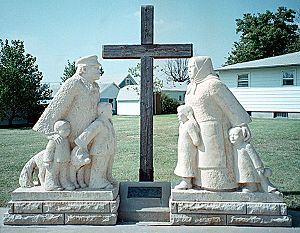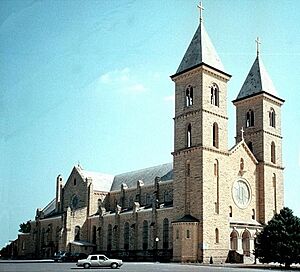Victoria, Kansas facts for kids
Quick facts for kids
Victoria, Kansas
|
|
|---|---|
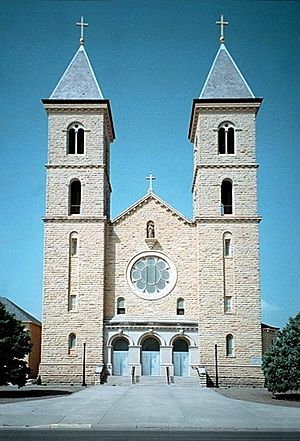
The Basilica of St. Fidelis (1997)
|
|
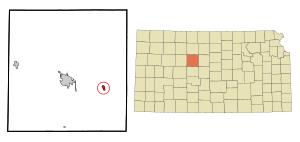
Location within Ellis County and Kansas
|
|
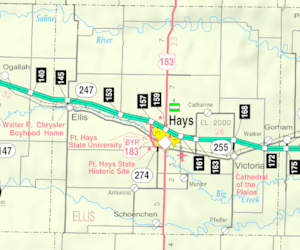
|
|
| Country | United States |
| State | Kansas |
| County | Ellis |
| Founded (station) | 1873 |
| Platted (Victoria) | 1880 |
| Incorporated | 1913 (merger with Herzog) |
| Named for | Queen Victoria |
| Area | |
| • Total | 0.60 sq mi (1.55 km2) |
| • Land | 0.60 sq mi (1.55 km2) |
| • Water | 0.00 sq mi (0.00 km2) |
| Elevation | 1,933 ft (589 m) |
| Population
(2020)
|
|
| • Total | 1,129 |
| • Density | 1,882/sq mi (728.4/km2) |
| Time zone | UTC-6 (CST) |
| • Summer (DST) | UTC-5 (CDT) |
| ZIP code |
67671
|
| Area code | 785 |
| FIPS code | 20-73775 |
| GNIS ID | 2397136 |
Victoria is a small city in Ellis County, Kansas, United States. It is located in Herzog Township. In 2020, about 1,129 people lived there.
Contents
History of Victoria
The city of Victoria began in 1867. This was when the Kansas Pacific Railway was being built. The railroad aimed to connect St. Louis to Denver. It also helped open up land for new settlers.
The railroad's path changed suddenly. This upset a group of Dog Soldiers, a Cheyenne military society. They attacked a camp that was building a bridge. This led to the Battle of the Saline River. After this, there were two years of fighting.
The Victoria Colony
George Grant was a rich businessman from Scotland. In 1873, he came to Kansas with about 30 young people. They were from noble families in Scotland and England. Some were "remittance men," meaning their families sent them money to live on.
Grant wanted to create a ranching community. Some of the nobles hoped to build large estates. This group brought special Aberdeen Angus cattle. Some of these cattle came from Queen Victoria's own farms. These cattle helped start the American Angus breed.
The colony settled on land about 10 miles wide. It stretched from the railroad tracks south to the Smoky Hill River. The settlement was named Victoria to honor Queen Victoria. The Kansas Pacific Railroad built a fancy stone station and hotel for the colony. It was called the Victoria Manor. It had nice rooms for people waiting for their new homes. The ground floor even had a ballroom for parties. Over 200 British people arrived in the next few years.
Grant brought a British architect, Robert William Edis, to the colony. He designed Grant's house and the town layout. Grant also built the St. George Episcopal church, a stone building. It was finished in 1877 and was the first church in the county.
Many colonists were more interested in sports and dancing than farming. They hired others to manage their farms. When their families found out, they sent less money. This made many colonists leave. George Grant died suddenly in 1878. This made even more people leave the colony. Some went back to Britain, and others went to South America. Grant was buried at the St. George Church. The town of Victoria was officially mapped out in 1880. This was done by the remaining colonists, especially Grant's niece, Margarat Grant Dunan.
Today, the church grounds are mostly a cemetery. There is a monument there to George Grant. It honors his help in starting the American Angus cattle breed. While most English settlers left, some Scottish families stayed. These include Grant's descendants and the Philips family. Four members of the Philips family later became Mayor of Hays.
Herzog Settlement
In 1875, a group of Volga Germans came from Russia. They were looking for a place to build traditional farming villages. They found land in Ellis County. The first place they saw was not good. But then they found better spots in the eastern part of the county.
They started the first Volga-German village near the Victoria Station. It was called "Herzog or North Victoria." As more German villages formed, Herzog's Roman Catholic settlers built churches. The most famous one is St. Fidelis Catholic Church. It is known as "The Cathedral of the Plains." It was finished in 1911.
When the Germans first arrived, Victoria only had the station-hotel and one other building. Herzog grew quickly. Later, Herzog and the smaller Victoria joined together. They became one city named Victoria in 1913.
Many German-Russian settlers came to Ellis County. They farmed and lived in communities like they did in Russia. They even wore Russian clothes and spoke some Russian. Because of this, people in Kansas called these settlements "Little Russia." Herzog was so important that it was called "Russia Minor."
Herzog was a religious community. Catholic services were first held outdoors around a cross. Then they moved to the home of Alois Dreiling. This house soon became too small. So, a wooden addition was built onto the home for church services. This was the second church built in the county. But even this was quickly too small.
Sir Walter C. Maxwell, the only Catholic in the Victoria Colony, was interested in Herzog. He built a stone church for the town in 1877. This church was also too small almost as soon as it was finished.
The Kansas Pacific Railroad gave 10 acres of land for the community's religious use in 1879. Father Anthony Mary arrived in 1881. He started building the first St. Fidelis Church in Herzog. It could seat 600 people. Construction began in 1880, and the church was dedicated in 1884.
Even this large church was not enough for the growing town. So, the St. Fidelis Cathedral, "The Cathedral of the Plains," was built between 1908 and 1911.
Victoria Auxiliary Field
In 1942, the U.S. Army built Walker Army Airfield. It was about 3 miles northeast of Victoria. During World War II, thousands of soldiers were stationed there. Most trained to fly the Boeing B-29 Superfortress bomber plane. The military closed the base in 1946. In 1949, the United States Air Force named it "Victoria Auxiliary Field." However, they never used the facility.
Bypassed by the Interstate
The main road, U.S. Highway 40, used to go through Victoria. But in 1966, Interstate 70 was finished in Ellis County. This new highway went north of Victoria. This meant less traffic went through the town. While the Interstate increased traffic in the area, bigger cities like Hays and Salina grew more than Victoria.
Geography
Victoria is in northwestern Kansas. It is located on Kansas Highway 255 (K-255). This is about 1 mile south of Interstate 70. Victoria is about 9 miles east of Hays, which is the county seat. It is also about 129 miles northwest of Wichita. Kansas City is about 243 miles to the west.
The city is about 9 miles north of the Smoky Hill River. This area is part of the Smoky Hills region of the Great Plains. Victoria sits on the east side of the North Fork of Big Creek. This creek flows into the Smoky Hill River.
The United States Census Bureau says Victoria covers about 0.59 square miles of land. There is no water area within the city limits.
Population and People
| Historical population | |||
|---|---|---|---|
| Census | Pop. | %± | |
| 1920 | 600 | — | |
| 1930 | 637 | 6.2% | |
| 1940 | 884 | 38.8% | |
| 1950 | 988 | 11.8% | |
| 1960 | 1,170 | 18.4% | |
| 1970 | 1,246 | 6.5% | |
| 1980 | 1,328 | 6.6% | |
| 1990 | 1,157 | −12.9% | |
| 2000 | 1,208 | 4.4% | |
| 2010 | 1,214 | 0.5% | |
| 2020 | 1,129 | −7.0% | |
| U.S. Decennial Census | |||
In 2010, there were 1,214 people living in Victoria. There were 496 households, and 316 of these were families. Most people in Victoria were White (98.5%). A small number were American Indian, African American, or other races. About 0.5% of the population was Hispanic or Latino.
About 29.6% of households had children under 18. Many households (53.4%) were married couples living together. The average household had 2.30 people. The average family had 2.93 people. The median age in the city was 41.7 years.
Economy and Jobs
In 2012, about 61.5% of people over 16 years old had jobs. Most people worked in:
- Education, health care, and social help (24.1%)
- Farming, forestry, fishing, hunting, and mining (10.7%)
- Wholesale trade (8.2%)
The cost of living in Victoria is lower than the U.S. average. For example, if the U.S. average is 100, Victoria's cost of living is 81.5. In 2012, the average home value was $101,200.
Education
Victoria has its own public school district, called Victoria USD 432. It runs two public schools in the city:
- Victoria Grade School (for students in Pre-Kindergarten through 6th grade)
- Victoria High School (for students in 7th through 12th grade)
Infrastructure
Transportation
Interstate 70 and U.S. Route 40 run together east-west. They are about one mile north of Victoria. K-255 runs north-south from I-70 into Victoria.
The Kansas Pacific (KP) railroad line, part of the Union Pacific Railroad, runs through the southern part of the city.
Utilities
The city government handles water, sewer, and trash services. Midwest Energy, Inc. provides electricity. Most homes use natural gas for heating, provided by Kansas Gas Service.
Media
Victoria is part of the Wichita-Hutchinson, Kansas television market. This means people in Victoria get their TV channels from this area.
Culture and Fun Things to Do
Events
The Herzogfest is Victoria's yearly community festival. It celebrates the city's German heritage. It happens in August and includes:
- Music concerts
- A tractor pull
- Games for children
- Other local entertainment
- Delicious German food and other foods from vendors
Places to Visit
- The Basilica of St. Fidelis is in Victoria. It is also known as "The Cathedral of the Plains." Local Roman Catholic residents built it because their old churches were too small. Construction began in 1908 and finished in 1911. It was built from local limestone. William Jennings Bryan gave it its famous nickname in 1912. In 2014, it became a minor basilica.
- Grant Cemetery is where George Grant and a few others from the 1880s are buried. It is on the land of the St. George Church, which Grant founded. Every 50 years, the American Aberdeen-Angus Breeders' Association celebrates the first Aberdeen Angus herd in the U.S. In 1973, for the 100-year celebration, artist Pete Felten Jr. made a limestone sculpture of a Black Angus cow.
- Railroad Workers Cemetery is a burial site for workers who died in 1967. They were killed while digging near the railroad bridge by Cheyenne Dog Soldiers. This event led to the Battle of the Saline River.
- St. Fidelis Cemetery has over 100 traditional German iron cross grave markers. It has the most iron crosses among the Volga-German cemeteries. Some gravestones here were carved from the special local Fencepost limestone by John Linenberger.
Notable People
Some well-known people who were born or lived in Victoria include:
- Monty Beisel (born 1978), a football linebacker
- Lucy Isabella Buckstone (1857-1893), an actress
- Nate Dreiling (born 1990), a football linebacker
- James "Scotty" Philip (1858-1911), a rancher who helped save American bison
- Theodore McCarrick, a former Archbishop of Washington, D.C.
Sister Cities
 Kubelstein, Scheßlitz, Germany
Kubelstein, Scheßlitz, Germany
See also
 In Spanish: Victoria (Kansas) para niños
In Spanish: Victoria (Kansas) para niños



